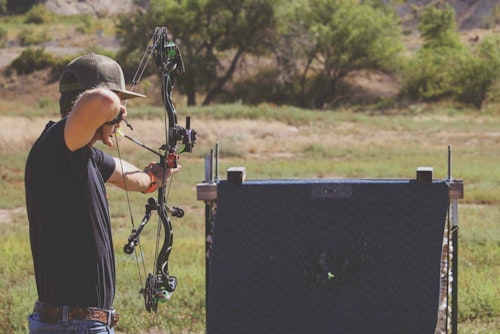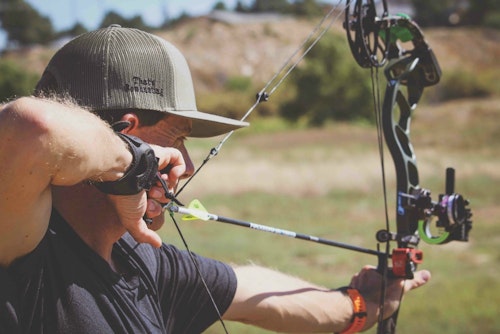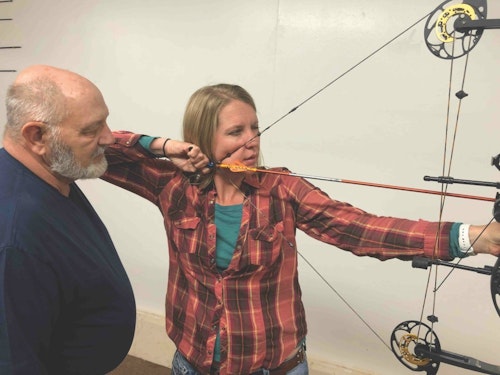The text message was hard to read. It was from a good buddy, one who had been fighting target panic for a grip of time. The disease, as it often does, had crept in slowly. Then it grew into a fire-breathing dragon, sucking the joy of archery right out of him.
The text read, “I shot with my son last night at a 4-H event. It was just a for-fun deal, and I could barely put my pin on the target. I was all over the place. I need help. I went to my local pro shop. That was a joke. The owner worked with me for a few minutes, telling me that my only problem was my breathing and my grip. That was it. That was his advice. I think I’m just going to sell my bow. This isn’t fun anymore.”
His words broke my heart. Why? I love archery and want to see people enjoy this great sport. Mostly, though, I’d been in his shoes a few years earlier. The only difference was I had the opposite experience when it came to coaching help.
More Than the Gear
You don’t need me to tell you that being a successful pro shop owner is about more than having shelves lined with top-end gear. You know that. The question is: Just how far are you willing to go to help your customers suffering from target panic?
Think about that question for a bit, because it’s an important one. I took the time to survey 250 archers. Some I knew well, others I didn’t know at all. The one question asked of each: Have you ever suffered with some form of target panic? The results: Out of the 250 archers surveyed, 247 admitted to dealing with some bout of target panic. As for the three oddballs, they were all new shooters, having been in the sport for less than 2 years.
What does this data mean to you? It should tell you that well over half of your customer base either suffers from or has suffered from target panic. Sure, you offer range time, equipment rentals and even instructional classes. With that noted, do you have a special program for target-panic goers? If not, you should.
My Struggle
It had been a dismal year. My 3-D season ended poorly, whiffing on three of my last four 3-D targets. I was pissed! Of course, the prideful me told myself that hunting season would be different. I would shoot more and get it figured out on my own. Ha! What a pile of BS I was feeding myself — no different than an opioid addict convincing themselves that they can conquer the problem without help.
How did hunting season go? Three misses and two poor hits that resulted in lost game. Disgusting, I know, but sugar-coating it and not speaking the truth isn’t going to help anyone. I did spine a pronghorn at a distance of 14 yards. I don’t even remember settling the pin. That’s because I didn’t. I drew. I shot. I got extremely lucky.
Do you know how many bowhunters are sitting in treestands and ground blinds right now struggling with the same or close to the same issues as mine? Piles of them. They are looking for help, but don’t know where to turn. They need help. They need you.

Be the Doctor
You know that feeling you get when you go to the doctor and they effectively diagnose your problem and let you know they can and will fix it? It’s a great feeling. It fills you with hope and joy. You need to be the target panic doctor.
Phil Mendoza owns and operates No Limits Archery in Denver, Colorado. In addition to authoring the book, “Targeting Buck Fever: A Bowhunter’s Guide To Regaining Control,” Phil is an accomplished backcountry hunter, archery coach and certified gear guru.
“You have no process,” Phil told me. “You’re just shooting. You need to get a system. Unless you can put a system in place, this isn’t going to go away.”
When it comes to target panic, Phil is the doctor, and he and his team at No Limits Archery host an all-day workshop that includes both classroom and on-the-range training. The workshop is completely hands-on and is set up to help veteran and novice archers alike.
I don’t live in Denver. In fact, I live 3 hours from the Centennial State’s capital city, so Phil went the extra mile. We discussed a lot of topics over the phone, and because he now has online classes set up, I was able to enroll in Bowhunting Building Blocks 3.0 – Building Your Bowhunting System.
Phil shipped me a tension-style release, which he carries in his shop. The exact model was the PerfeX Resistance by Stanislawski. This particular release utilizes a thumb-button that acts as a safety. As long as the thumb is depressed, the release can’t fire. Once full-draw is reached and the archer climbs into his/her anchor, the thumb-button is released. The only thing that can now fire the release is tension, which can be easily altered via a set screw. Over time, I learned to stop thinking about the shot and just let my pin float on a spot. As my emotions calmed, and anchoring and aiming became part of my system, I found the shot was just gone. I shot that tension-style release for months — perfecting my system and following Phil’s course before switching to T.R.U. Ball’s Hot Tension hinge.
“The tension-style release is a big deal,” Phil said. “It simply forces the shooter to aim, and they don’t have to worry about over rotating and punching themselves in the face, which can happen with a true hinge. It’s awesome to see a once panicked archer regain control. I have several of these releases that I keep on the range. Guys and gals are free to try them, and once they realize they can’t punch them, most purchase a release. Some stick with the tension-activated release, and I have lots of clients that actually hunt with them. Most end up switching to a hinge or go back to an index or thumb once they’ve regained control of their shooting. I always tell guys and gals to hunt with the release they are most comfortable with.”
By offering both regular and online classes, Mendoza and his staff are able to help throngs of archers. Just food for thought.

Can You Coach?
I was an average high school football player. My good buddy, on the other hand, was Wyoming’s Gatorade Player of the Year and heavily recruited by a number of colleges. He’s now a football expert, but he’s not a coach. His patience is non-existent, and he simply can’t convey to others what he’s trying to explain. I’m not bagging on him; he would tell you the same thing.
I taught fifth-grade for 9 years and have three kids. I have loads of patience and was blessed with the ability to teach. Though I wasn’t as good of a football player as my friend, I’m a better coach. Kids respond well to my teaching, and it’s easy to track their improvement.
Why tell you this? Because you need to be honest with yourself. You may be an accomplished bowhunter and archer, but do you have the patience and ability to teach others? It’s a question you have to ask yourself, and you have to be honest. If the answer is yes, get after it. If the answer is no, that doesn’t mean you can’t reach out to your target-panic stricken crowd.
Do you have a few shop shooters? A few guys and gals who come into your shop and, before you know it, are mentoring both adults and kids? Chances are you do, and you need to approach these individuals.
Another shop owner friend of mine, a guy who can shoot the hair off a gnat at 80 yards with his stick and string, told me, “I can shoot. I know the process. I know what works for me. However, I can’t teach to save my life. I do offer classes in target panic, but I don’t teach them. I pay and trade products to a trio of shooters in my shop. These guys are excellent shots, are USA Archery Certified instructors and do an excellent job.
“Since starting my target panic classes, my release sales have skyrocketed. I’m also getting more guys and gals in the door because the people we are helping are advertising for us. They are conquering their target panic and letting others know. You don’t get in a circle of archers very often and not have the subject of target panic come up. When they are in these circles, they share their story and we get new people coming in. Last month we offered three classes and limited the number of shooters to six per class. We filled up, and now have a waiting list.”
Keep It Small
The key to offering target panic classes is to keep the class size small. Shooting in front of lots of men and women builds anxiety, and these archers already have enough of that. By keeping the class small, the group can bond and get comfortable with one another. Plus, keeping the class size small allows you to provide more individual attention to each shooter.
With the majority of archers — bowhunters included — struggling with some form of target panic at some point, a pro shop should be equipped to offer solutions for overcoming the disorder. Finding a “doctor” that can also coach is the best practice for optimal outcomes of individual shooters. Keep class sizes small to ensure as much individual attention as possible. Your customer service will pay dividends down the road.
Sidebar: Become a Coach
Let’s go back to the doctor idea for a minute. A few weeks back we had to take my son to see an orthopedic surgeon. On his walls were piles of framed degrees, as well as certificates that displayed his ongoing education. This made us feel good, and when your customers come to your shop and discover you are a Certified USA Archery Instructor, it will make them feel good, too.
There are currently five levels of certification offered by USA Archery. Some of those levels offer more than one certification. The levels include: Level 1 Instructor Certification, Level 2 Instructor Certification, Level 2 Instructor Trainer Certification, Level 3 NTS Coach Certification, Level 3 NTS Coach Trainer Certification, Level 4 NTS Coach Certification and Level 5 NTS Coach Certification. Get certified and start coaching. For more information on each certification level and where to attend classes, visit www.usarchery.org.








